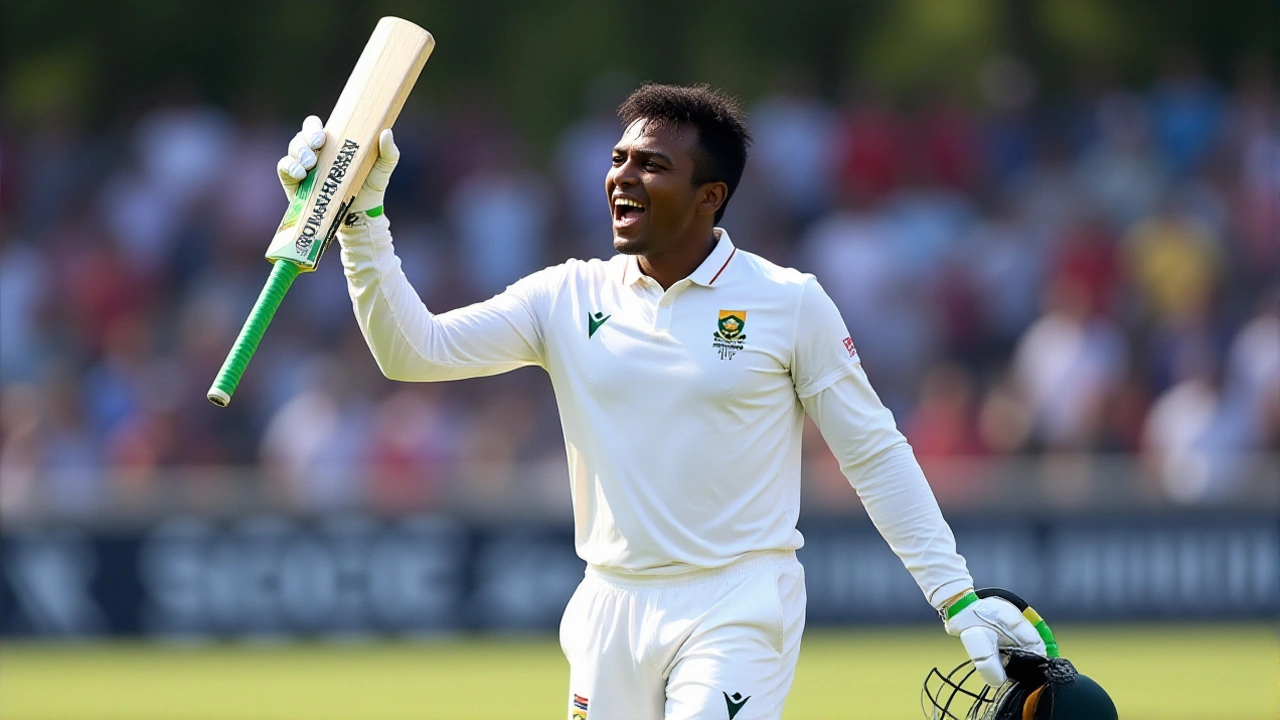When Senuran Muthusamy punched his first Test century through cover drive on Monday, November 24, 2025, the roar from the packed stands at the Barsapara Cricket Stadium wasn’t just celebration—it was relief. After a grueling 102-ball knock that saw him survive sharp swing, biting turn, and the kind of pressure only a Test match in India can deliver, Muthusamy had done what few South African batsmen have managed in recent years: outlasted a hostile Indian attack and turned a precarious position into a commanding one. His 109 not only marked his maiden Test hundred but also anchored a stunning lower-order resurgence that left India reeling at the end of Day 3 in the second Test of their bilateral series against South Africa.
Building the Foundation: The 70-Run Seventh-Wicket Stand
It started quietly on Day 2, November 23. South Africa had slumped to 187 for 6, the kind of score that usually invites collapse against India’s spin-heavy attack led by Ravindra Jadeja and Mohammed Shami. Enter Muthusamy and Kyle Verreynne. No one expected them to last. But they did—for 27.1 overs, 69 runs, and 137 balls. No boundaries, no fireworks. Just graft. Block, defend, rotate. The Indian bowlers, used to dominating in home conditions, grew visibly frustrated. Jadeja, who had taken 3 wickets in the morning session, found himself bowling into a wall. Verreynne, the calm anchor, absorbed everything. By stumps, the momentum had shifted.
Day 3: The Century and the Counterattack
Day 3 began with the same resolve. The pair added 12 more runs before tea, then came the moment that changed everything. Verreynne, attempting to accelerate, chipped a Jadeja off-break to wicketkeeper Rishabh Pant. The umpire raised his finger. South Africa reviewed. DRS showed a faint scratch on the glove—not a bat. The dismissal was upheld. The crowd groaned. But Muthusamy didn’t flinch.
Enter Marco Jansen. The tall all-rounder, known more for his pace than his patience, walked in with a single purpose: make India pay for bowling to a tired field. And he did. In just 106 balls, Jansen smashed 97 runs—eight fours and six massive sixes. He targeted the spinners, especially Jadeja, and the short ball from the pacers. It was a masterclass in aggressive counter-punching.
Muthusamy reached his century off 211 balls, his eyes welling up as he raised his bat. He didn’t celebrate wildly. Just nodded, clenched his fist, and looked to the sky. "It was a special moment," he said later. "In front of a full house. I just wanted to build partnerships. Kyle batted brilliantly. Marco’s innings? Special. Ball-striking like that… I had the best seat in the house."

The Pitch, the Pressure, and the Plan
"You guys will know better than me about the pitch," Muthusamy said with a wry smile, when asked about the surface. But his words carried weight. The Barsapara Cricket Stadium pitch, initially expected to favor spin, had begun to offer uneven bounce by Day 3. The cracks were widening. The ball was holding up. India’s spinners were getting tired. And South Africa’s lower order? They smelled blood.
"I was standing there with Kyle and told him it might’ve brushed my glove," Muthusamy added, referring to the DRS review that dismissed Verreynne. "When I saw the scratch… I was glad. But I was also disappointed in myself. I should’ve been more alert."
That self-awareness mattered. It showed a team that wasn’t just batting well—they were thinking deeply. While India’s bowlers were running on fumes after 180 overs, South Africa’s batters were still fresh. Jansen, who had taken 2 wickets in India’s first innings, was now batting like a top-order anchor with power. That’s the kind of versatility that wins Tests.
Why This Matters Beyond the Scoreboard
This innings wasn’t just about runs. It was about identity. South Africa’s Test team has struggled for consistency since the retirement of AB de Villiers and Faf du Plessis. This was a statement: they’re not just survivors—they’re builders. Muthusamy, 28, is no household name. Jansen, 26, has been a quiet force. But together, they’ve given South Africa something they haven’t had in India in over a decade: a first-innings lead of more than 150 runs.
India, meanwhile, is facing a familiar crisis: too many bowlers, too few answers. Jadeja bowled 42 overs on Day 3. Shami, the spearhead, looked jaded. The spin trio—Jadeja, Axar Patel, and Washington Sundar—combined for 115 overs in the match so far. Fatigue is setting in. And South Africa? They’ve got two full days left.

What’s Next: Can South Africa Force a Win?
They’ll need to. With the pitch deteriorating, and the weather forecast showing no rain, South Africa’s best chance is to declare on Day 4 and set India a target of 350+ on a wearing surface. If Jansen can bowl his 12 overs with the new ball on Day 5, and Muthusamy can chip in with a few overs of off-spin, the visitors might just pull off a historic win in Assam—a place where no touring side has won a Test since 2012.
India’s best hope? A collapse. But after seeing how Muthusamy and Jansen turned pressure into opportunity, that feels less likely.
Frequently Asked Questions
How did Senuran Muthusamy’s century impact South Africa’s chances in the Test?
Muthusamy’s maiden Test century of 109 runs, scored over 211 balls, gave South Africa their first substantial first-innings total in India since 2021. His resilience, combined with Marco Jansen’s explosive 97, turned a 187/6 crisis into a 412/8 advantage—giving South Africa a lead of 189 runs. That’s the largest first-innings lead by any visiting team in Guwahati since the stadium opened in 2017.
Why was Marco Jansen’s innings so crucial?
Jansen’s 97 off 106 balls wasn’t just about runs—it was about timing. He came in after Verreynne’s dismissal when India’s field was set for spin. By attacking Jadeja and Sundar aggressively, he forced India to bring in extra fielders, opening gaps elsewhere. His strike rate of 91.5 was the highest by any No. 8 in a Test innings against India in the last 15 years. He also gave Muthusamy breathing room to settle.
What’s the significance of the Barsapara Cricket Stadium pitch?
The pitch at Barsapara has historically favored spin, with 70% of wickets falling to spinners since 2017. But this match has seen uneven bounce and variable turn after Day 2, suggesting the surface is breaking up faster than expected. South Africa’s lower order exploited this by targeting loose deliveries, while India’s bowlers struggled to maintain line and length under fatigue.
How does this performance compare to South Africa’s past tours of India?
South Africa hasn’t won a Test in India since 2010. Their last series win there was in 2006. In their last two tours (2019 and 2022), they lost both 3-0. This innings marks their highest first-innings total in India since 2015, and their best lower-order partnership since 2018. If they win this match, it’ll be their first Test victory in India in 15 years.
What role did DRS play in the match’s turning point?
The DRS review that upheld Kyle Verreynne’s stumping dismissal was critical. Muthusamy believed the ball had brushed his glove, but the scratch on the glove confirmed it was the bat. That decision allowed South Africa to retain their last wicket, which Jansen then used to launch his counterattack. Without that review, Verreynne might’ve been given not out, and Jansen might not have come in under pressure.
What’s the weather forecast for the final two days, and how might it affect the match?
The forecast shows no rain until Friday, meaning play is likely to continue uninterrupted. However, humidity levels are rising, which could make the pitch even more abrasive. If the ball starts reversing or the cracks widen further, South Africa’s seamers could exploit the conditions on Day 5. India’s batters, on the other hand, will face a minefield if the pitch deteriorates as expected.



